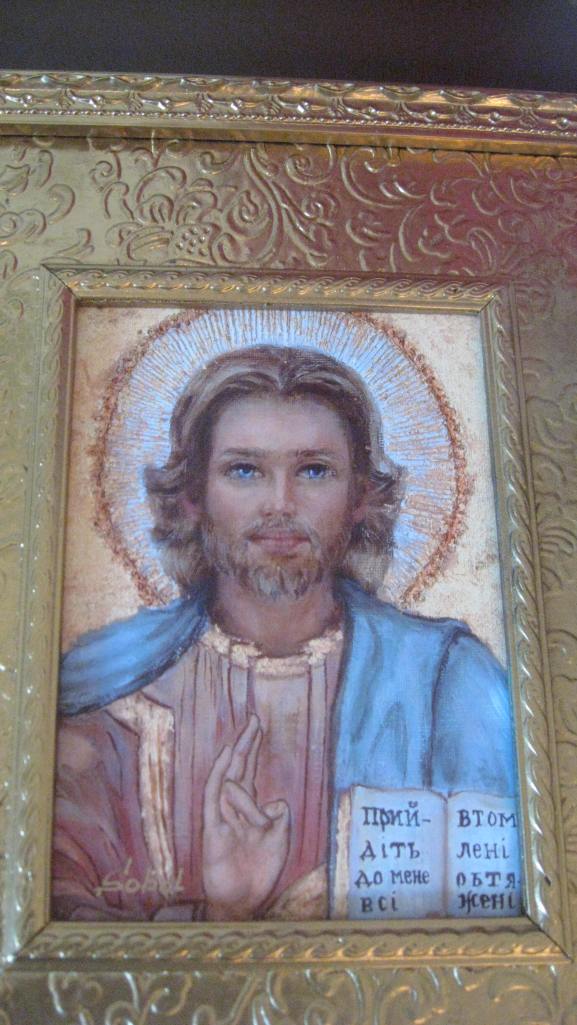 (icon courtesy of Holy Transfiguration Monastery)
(icon courtesy of Holy Transfiguration Monastery)
I came across this beautiful icon for the first time yesterday at the home of fellow parishioners from St. Mary’s Orthodox Church who are Chinese-American.
It reminded me of a church calendar that a Catholic Korean-American friend had hanging over her desk. In all the images, Mary and Jesus were depicted as Asian. It seemed to be a fairly run-of-the-mill item, so I am surprised not to be able to find a similar image online. But it looked something like this, just more stylized:
 Which is lovely, artistically, but not really any different from this:
Which is lovely, artistically, but not really any different from this:
There are more  than enough rants of all sorts in various corners of the Internet about ethnic representations of Jesus, and I don’t mean to fight my way into that over-saturated market. In the spirit of some earlier posts, however, I’d like to note that, while the desire to see one’s ethnicity represented in one’s religious imagery is a natural one, there are appropriate and inappropriate ways to act upon it.
than enough rants of all sorts in various corners of the Internet about ethnic representations of Jesus, and I don’t mean to fight my way into that over-saturated market. In the spirit of some earlier posts, however, I’d like to note that, while the desire to see one’s ethnicity represented in one’s religious imagery is a natural one, there are appropriate and inappropriate ways to act upon it.
One can make Christianity into a local paganism and Christ into a local deity, outfitted to look just like the people hoping to acquire His special protection. That is, essentially, the achievement of the four images directly above. Today, this seems to come increasingly from theories of racial victimhood, touting the supposed disempowerment of certain ethnic groups wrought by religious imagery in which members of those groups cannot see themselves. If Jesus, Mary, etc. are often depicted as “white” (rather than Jewish) in traditional Christian art, it is due to a pagan spirit within Europe. Nothing Christian is achieved by replicating that pagan spirit in other cultural contexts.
But there is another way to see oneself and one’s group in religious imagery, of which the icon of the martyrs of the Boxer Rebellion reminds us. Jesus was a Jew, and salvation came from the Jews; it is a dangerous lie to deny or obscure this fact. But salvation came through Him to all people, God’s intention being to raise up saints from all nations and races, speaking all languages. To remember and venerate of the saints in our midst – whatever this “midst” happens to be, ethnically or otherwise, for a given individual – is to honor at once the universality of the Church and the particular origins of Christ.


Feast of the Evangelist and Iconographer Apostle St. Luke 2011
THE ICONOGRAPHER AS ‘FIFTH EVANGELIST’
As with the Orthodox struggle (and eventual) triumph over the iconolaters on the one hand,and the Iconoclasts on the other,now celebrated on the Feast of Orthodoxy, may the current (albeit slow) ascendancy towards a more Jewish representation of Christ Yeshua in similar vein prove a
prophetic forerunner!
Other than the beautiful Bat-Tzion series issuing from the school of American iconography,some Greek Orthodox icons of Jewish interest (to name a few),ought to include the following:
Ha Yeroushalayimiyah (Jerusalem Patriarchate)
The Hadassah Icon – St. Mary Myrtles (Kythera-Greece)
The Saidnayah Icon (Lebanon)
Our Lady of Khazan – Adonit Ha Olam (Russia)
The Kursk Root Icon of the Mother of God (Russia)
@Doron – Thanks! What about these icons (especially Khazan and Kursk) do you think is of particularly Jewish interest?
Shalom,
In response to the above,and to begin at the beginning:
Our Lady of Jerusalem – by association with Zion.
Our/The Lady of Myrtles – for the Sabbath symbolism of the myrtle tree and the Judeo-Phoenician origins of the Kytherians.
Saidnaya (Arabic:Our Lady) – thanks to the connection with both Antioch and Damascus;and the considerable conversions to Christianity in that region prior to the founding of the modern Jewish state.
Our Lady of Khazan and Kursk – ‘Our Lady of the Sign’ – for their purely Biblico-prophetic qualities as “Old Testament Mariology”.
I have mixed feelings about this, as it seems there is a tension between the principle of “What is not assumed cannot be saved” (in which case all human ethnicity could be understood to be effectively taken on, and it is not inappropriate to depict Christ in such a way) and the old “scandal of particularity,” especially when the Jewishness of Jesus has so often been elided….
I think the issue here is not only particularity but also the triumph of fact – Christianity being, importantly, a religion that is based on historical events – over self-serving imagination. If you can depict Christ any way you like, you can also construct Him any way you like in other realms, such as potentially theology.
For whatever reason, the icons themselves don’t seem to appear. In any case, the icon represents a non-literal depiction, so I am not clear this is right. Have you talked to a spiritual father/mother or a deeply rooted iconographer about this concern? In any case, is this a peculiarly modern modern notion: take Ethiopia for example – there are likely many icons that represent a more ethnic variant that likely represents the only thing the iconographers ever knew about how a person looks.
@anon – I certainly see your point about e.g. Ethiopia. But the icons I cited here are perfectly modern, and painted to make a particular point.